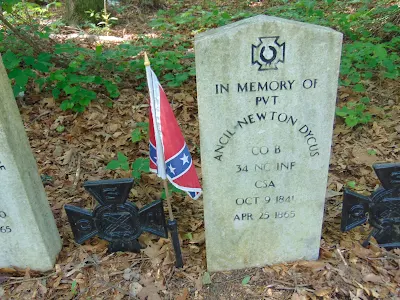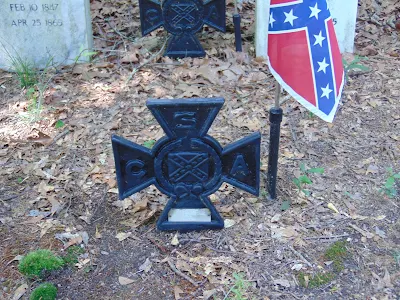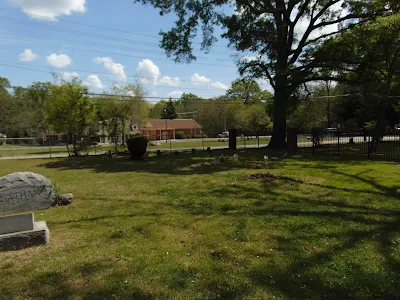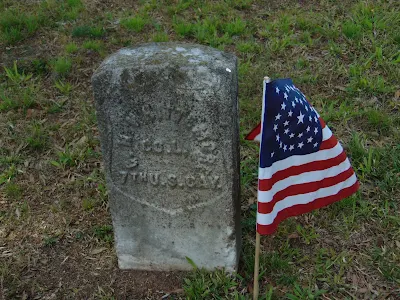At Flat Rock Cemetery in Mount Holly, North Carolina there are seven Southern Crosses of Honor and four grave stones honoring the memories of seven Confederate soldiers from Cleveland and Rutherford Counties in North Carolina.
These men were returning home from the War following the surrender of the Confederate Army of Northern Virginia at Appomattox Courthouse on Sunday, April 9, 1865. They fought for years in the war at places like Fredericksburg, Chancellorsville, Gettysburg, the Wilderness & Spottsylvania Campaign, and the Siege of Petersburg, and survived only to tragically drown mere miles from their homes and families.
As the local story goes, when these seven former Johnny Rebs reached the Mecklenburg County side of the Catawba River they discovered that none of the ferries were operating due to the extremely high water and turbulence due to rainstorms. Such was their haste to return home to their families they failed to wait for the water to calm down and hired a local boy and his fishing boat to ferry them across. The boat was either swamped by floating debris, or capsized because of the overcrowding, sending everyone into the torrential waters.
Of the seven men, only one -- Private Ancil Dycus -- was able to reach shore. But one of the other men in the water was his brother -- Private Joseph Dycus -- and he went back in to try to save his kinsmen, and the others. Sadly he too drowned while attempting to rescue them.
It is believed that the men were buried in Gaston County near the site were they drowned. No evidence can be found to determine the exact location. These veterans grave makers and Southern Crosses of Honor have been erected to preserve their everlasting memories for future generations.
These men were returning home from the War following the surrender of the Confederate Army of Northern Virginia at Appomattox Courthouse on Sunday, April 9, 1865. They fought for years in the war at places like Fredericksburg, Chancellorsville, Gettysburg, the Wilderness & Spottsylvania Campaign, and the Siege of Petersburg, and survived only to tragically drown mere miles from their homes and families.
As the local story goes, when these seven former Johnny Rebs reached the Mecklenburg County side of the Catawba River they discovered that none of the ferries were operating due to the extremely high water and turbulence due to rainstorms. Such was their haste to return home to their families they failed to wait for the water to calm down and hired a local boy and his fishing boat to ferry them across. The boat was either swamped by floating debris, or capsized because of the overcrowding, sending everyone into the torrential waters.
Of the seven men, only one -- Private Ancil Dycus -- was able to reach shore. But one of the other men in the water was his brother -- Private Joseph Dycus -- and he went back in to try to save his kinsmen, and the others. Sadly he too drowned while attempting to rescue them.
It is believed that the men were buried in Gaston County near the site were they drowned. No evidence can be found to determine the exact location. These veterans grave makers and Southern Crosses of Honor have been erected to preserve their everlasting memories for future generations.
 |
| Grave markers and Confederate Iron Crosses honoring seven Confederate soldiers who died returning home from the War |
 |
| This memorial stone set at the foot of the markers and crosses tells in brief the story of the tragedy end of these seven lives. |
 |
| Corporal Drury Dobbins Price Co. F 34th NC Infantry CSA. |
 |
| Private Ancil Newton Dycus Co. B 34th NC Infantry CSA. |
 |
| Private Joseph J. Dycus Co. D 2nd NC Junior Reserves CSA |
 |
| Private James Blanton Co. B 34th NC Infantry CSA. |
 |
| A. Greene -- CSA. RIP. |
 |
| John Greene -- CSA. RIP. |
 |
| John B. Owens -- CSA. RIP. |
 |
| Flat Rock Cemetery -- named for a large flat rock adjacent to the cemetery -- is located on North Main Street (HWY 273) in Mount Holly, North Carolina. |
"The righteous perish,
and no one ponders it in his heart;
devout men are taken away,
and no one understands
that the righteous are taken away
to be spared from evil.
Those who walk uprightly
enter into peace;
they find rest as they lie in death."
~ Isaiah 57:1-2 (NIV)
and no one ponders it in his heart;
devout men are taken away,
and no one understands
that the righteous are taken away
to be spared from evil.
Those who walk uprightly
enter into peace;
they find rest as they lie in death."
~ Isaiah 57:1-2 (NIV)
Deo Vindice!
UPDATE! 05-09-2020
Earlier this year members of the Stonewall Jackson Camp #23 Sons of Confederate Veterans (SCV) installed three new grave stones for the Greene brothers and Private Owens. A dedication service for the new markers took place on Saturday, May 9th in honor of Confederate Memorial Day. I was able to attend and my photos of the event can be seen HERE.
Earlier this year members of the Stonewall Jackson Camp #23 Sons of Confederate Veterans (SCV) installed three new grave stones for the Greene brothers and Private Owens. A dedication service for the new markers took place on Saturday, May 9th in honor of Confederate Memorial Day. I was able to attend and my photos of the event can be seen HERE.
 |
| Thank you for the work you have done, gentlemen! |





























